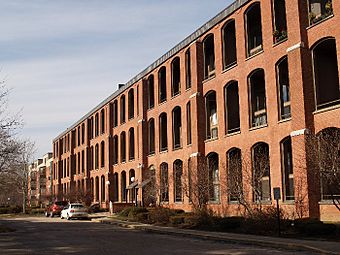Old Colony Iron Works-Nemasket Mills Complex facts for kids
Quick facts for kids |
|
|
Old Colony Iron Works-Nemasket Mills Complex
|
|

Former Nemasket Mill
|
|
| Location | Taunton, Massachusetts |
|---|---|
| Built | 1834 |
| Architectural style | Colonial Revival |
| MPS | Taunton MRA |
| NRHP reference No. | 84002190 |
| Added to NRHP | July 5, 1984 |
The Old Colony Iron Works-Nemasket Mills Complex is an old industrial area in Taunton, Massachusetts. It's right next to the Taunton River and the town of Raynham. This site was first home to the Old Colony Iron Company, which started in the 1820s. Later, in 1889, the western part of the complex was sold to Nemasket Mills. The eastern part became home to the Standard Oil Cloth Company. This historic site was added to the National Register of Historic Places in 1984, which means it's recognized as an important place in history.
Contents
Old Colony Iron Works: Making Metal Goods
In 1813, a man named Stephen King built a dam across the Taunton River. Later, in 1823, Horatio Leonard & Company took over. They built a new dam and started an iron works. This company made things like nails, tacks, and rolled iron until 1842.
From 1836 to 1854, the Taunton Tow Path Company used barges. These barges traveled along canals built next to the river. This helped them get around the dam.
A New Company Takes Over
In 1843, a group of business people bought the iron works. This group included Samuel L. Crocker and the Robinson brothers. The Robinson brothers had worked for Horatio Leonard since 1827.
In 1844, this new group formed the Old Colony Iron Company. They quickly made the factory bigger. By 1871, they had a rolling mill and a nail mill. These were on the west side of Old Colony Avenue. They also had a shovel mill on the east side.
Producing Many Nails
By the mid-1870s, the Old Colony Iron Company was very busy. They made more nails than any other company in New England. They produced as many as 130,000 kegs of nails each year. By 1876, their factory had many machines. These included furnaces, nail machines, and hammers. They used both water and steam power.
Challenges and Changes
In August 1881, the company faced a big problem. A fire destroyed their nail factory and a mill that made tack plates. Luckily, the shovel mill was saved. Instead of rebuilding the nail mill, the company bought another factory. This factory was in nearby Somerset, Massachusetts. They did rebuild the tack plate mill in East Taunton.
After the fire, the company focused more on making rolled steel plates for shovels. However, it became harder for iron works in New England to compete. Factories in Pennsylvania, the Midwest, and the Southern United States had easier access to coal and iron. This meant they could make goods much cheaper. By the late 1880s, many iron companies closed down. The Old Colony Iron Company sold its property in 1889.
The part of the iron works that made shovels was later used by the Standard Oil Cloth Company. In 1893, the Chandler Oil Cloth & Buckram Company was started. They made buckram, which is a heavy cotton cloth for book covers. They also made oilcloth, a strong waterproof fabric.
Nemasket Mills: Making Cotton Fabric
The Nemasket Mills Corporation started in 1891. They used the western part of the old Old Colony Iron Works site. This company made cotton textiles. Lewis Williams was the first president.
In 1899, the New England Cotton Yarn Company bought this mill. This company also owned the Cohannet Mill No. 3 in Taunton. They owned other mills in Fall River and New Bedford.
In June 1916, the company sold its mills in Taunton. The Cohannet Mill No. 3 was sold to William Butler. He renamed it the Nemasket Mill. The original Nemasket Mill (on Old Colony Avenue) was sold to the Connecticut Cotton Mills Company. This plant then operated as the Taunton Cotton Mills Company. They made cotton cord, which was used for tires.
Recent History: New Uses for Old Buildings
In the 1980s, the old Nemasket Mills building was changed. It became residential condominiums, which are apartments that people own. It's now called Riverbend Condominiums. A large new section was added to the back of the building.
An interesting change was how they handled the windows. The original large window panes were removed. A new wall was built behind the old openings. This created balcony areas for the people living there.
The part of the complex on the east side of Old Colony Avenue used to be the shovel works. Today, it has different small businesses.



